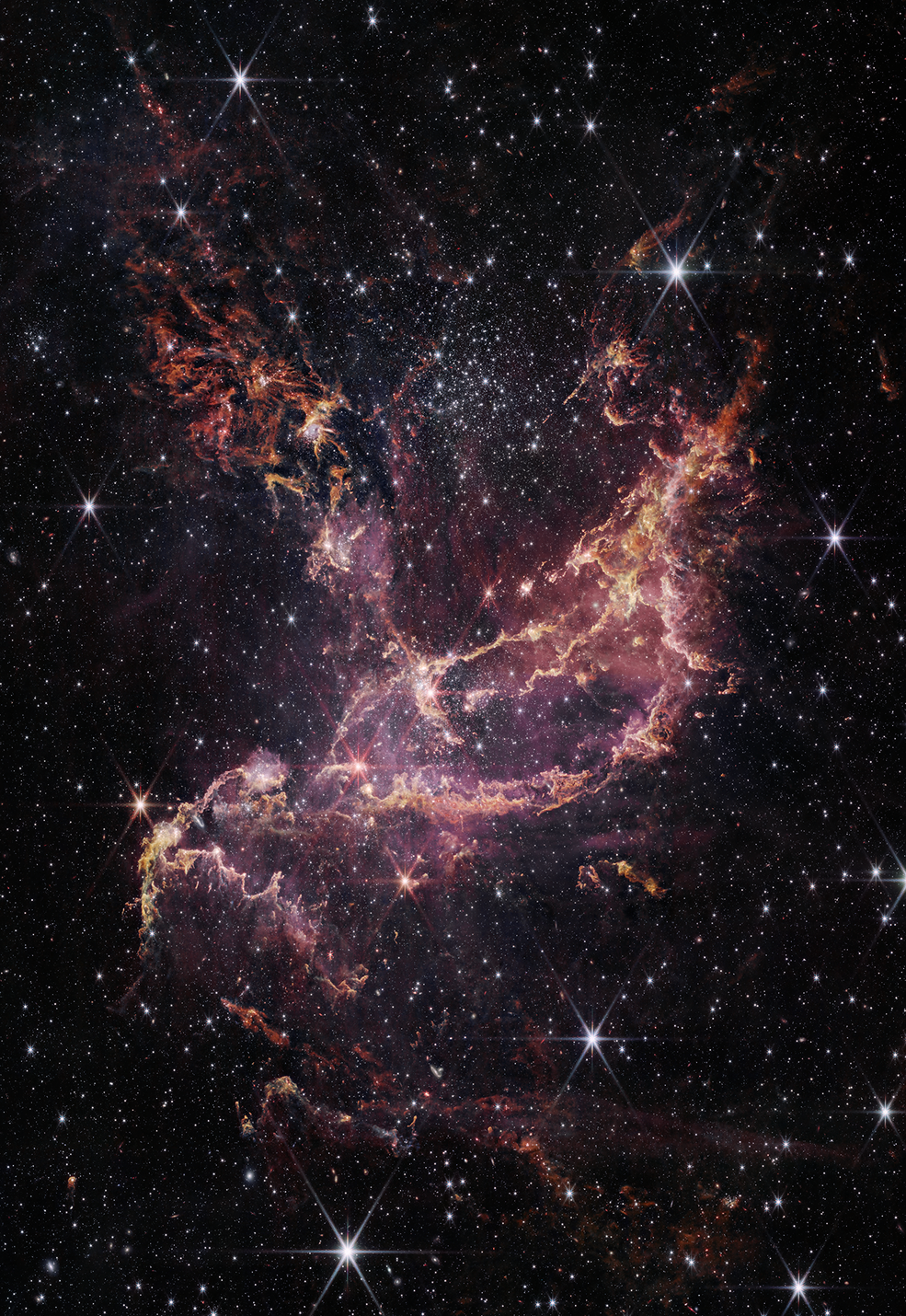The most powerful telescope ever devised zoomed in on the dynamic star-forming region NGC 346 for a clue as to how stars were born in the early universe.

Image Credit: NASA, ESA, CSA, Olivia C. Jones (UK ATC), Guido De Marchi (ESTEC), Margaret Meixner (USRA). Image Processing: Alyssa Pagan (STScI), Nolan Habel (USRA), Laura Lenkić (USRA), Laurie E. U. Chu (NASA Ames)
Located in the Small Magellanic Cloud, the small companion galaxy of the Milky Way 210,000 light years from Earth is a region of intense star formation, a nebula designated NGC 346.
The James Webb Space Telescope (JWST) has now zoomed in on NGC 346, studying the region in intense detail and observing its ribbons of gas and dust, thus unlocking some of the mysteries of this relatively close star-forming region.
Dwarf galaxies are considered to be the building blocks of larger galaxies, and like the Small Magellanic Cloud, contain more primeval material and less heavy elements, or ‘metals’ as astronomers call anything heavier than helium, than their larger counterparts.
Because it is the cycle of subsequent generations of stars dying in supernova explosions that enrich galaxies with heavy elements, the conditions in Small Magellanic Clouds resemble those that would have been present in early galaxies in the young universe.
That means studying these small galaxies can teach astronomers about how galaxies evolved, and looking at their star-forming regions can reveal details about the type of ‘metal-poor’ stars that populated early galaxies just 2 or 3 billion years after the Big Bang. This period — known as “cosmic noon” — also happens to be the time at which star formation in the universe was at its peak.
Previous studies of NGC 346 in infrared light have focused on protostars — young stellar bodies that haven’t yet been able to initiate their own nuclear fusion — with masses between 5 and 8 times that of the sun.
The JWST, the most powerful telescope ever placed into orbit, views the universe in infrared and can probe this region deeper, getting a good look at protostars with masses below 5 times that of the sun.
In fact, the observational power of the JWST has allowed astronomers led by Olivia Jones, a Science and Technology Facilities Council (STFC) Webb Fellow at STFC’s UK Astronomy Technology Centre (UK ATC), to study protostars with masses as small as just one-tenth of the sun’s mass.
This means that for the first time, the JWST is gathering infrared data that covers the full sequence of star formation, from high-mass to low-mass stars, in a galaxy other than the Milky Way.
The team’s findings were presented at the 41st meeting of the American Astronomical Society on January 11th, 2023.
Investigating Early Star and Planet Birth
The images from the JWST show gas gathering around protostars in NGC 346, dragged from the surrounding molecular cloud. This material forms an accretion disk that feeds the central protostar, helping it gather enough mass to kickstart the nuclear fusion process that transforms hydrogen to helium, a process that defines the main sequence lifetime of stars.
This could show if stars in the early universe are born in the same way as those in the Milky Way and if these two populations of stars demonstrate the same phenomena during their infancy.
In addition to this, the JWST was also able to detect dust in NGC 346 for the first time. The amount of dust found by the JWST is a surprise because this form of matter is usually composed of metals. That means metal-poor galaxies like the Small Magellanic Cloud and early galaxies would not be expected to possess much dust.
This discovery indicates that as well as forming stars, metal-poor galaxies may be better at forming terrestrial or rocky planets than astronomers knew.
Of course, one of the key differences between the Small Magellanic Cloud and a galaxy during the peak of star formation in the early universe is that the Milky Way’s dwarf companion has one star-forming region, while early galaxies would have had thousands. That implies that rocky planets could have formed earlier in the universe than previously believed and in greater numbers.
The JWST has also collected spectroscopic data from NGC 346 with its NIRSpec instrument that scientists are still analyzing. This could grant insight into the type of material accreting onto protostars and helping them grow.
More from AZoQuantum: James Webb Captures its First Direct Image of an Exoplanet
References and Further Reading
Star-forming region in nebula NGC 346, ESA, [Accessed 01/20/22], [https://www.esa.int/Science_Exploration/Space_Science/Star-forming_region_in_nebula_NGC_346]
NASA’s Webb Uncovers Star Formation in Cluster’s Dusty Ribbons, NASA, [Accessed 01/20/22], [https://www.nasa.gov/feature/goddard/2023/nasa-s-webb-uncovers-star-formation-in-cluster-s-dusty-ribbons]
Webb reveals new details on how stars formed in the early Universe, UKRI, [Accessed 01/20/22], [https://www.ukri.org/news/webb-reveals-new-details-on-how-stars-formed-in-the-early-universe/#:~:text=The%20James%20Webb%20Space%20Telescope,of%20particular%20interest%20to%20astronomers]
Disclaimer: The views expressed here are those of the author expressed in their private capacity and do not necessarily represent the views of AZoM.com Limited T/A AZoNetwork the owner and operator of this website. This disclaimer forms part of the Terms and conditions of use of this website.